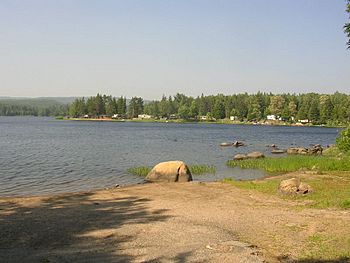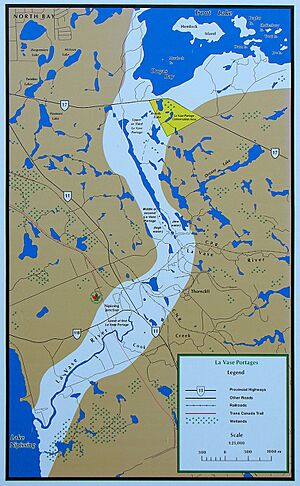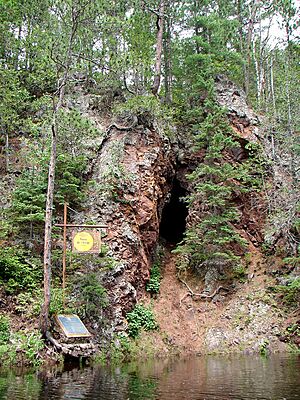Mattawa River facts for kids
Quick facts for kids Mattawa River |
|
|---|---|

Pimisi Bay on the Mattawa River
|
|
| Other name(s) | Petite Rivière |
| Country | Canada |
| Province | Ontario |
| District | Nipissing |
| Physical characteristics | |
| Main source | Trout Lake North Bay, Ontario 198.5 m (651 ft) 46°18′48″N 79°16′09″W / 46.31333°N 79.26917°W |
| River mouth | Ottawa River Mattawa, Ontario 148 m (486 ft) 46°19′13″N 78°42′26″W / 46.32028°N 78.70722°W |
| Length | 76 km (47 mi) |
| Basin features | |
| Progression | Ottawa River→ Saint Lawrence River→ Gulf of Saint Lawrence |
| River system | Ottawa River drainage basin |
| Basin size | 1,170 km2 (450 sq mi) |
| Tributaries | |
The Mattawa River is a beautiful river in central Ontario, Canada. It starts at Trout Lake near North Bay and flows east. The river then joins the big Ottawa River at the town of Mattawa. It is about 76 kilometers (47 miles) long. The name "Mattawa" comes from the Algonquin people. It means "meeting of waterways," which is perfect for this river!
Two special parks are found along the Mattawa River. These are the Mattawa River Provincial Park and Samuel de Champlain Provincial Park. The Mattawa River Provincial Park covers almost the entire length of the river. Samuel de Champlain Provincial Park is located about 10 kilometers (6 miles) from where the river ends.
Contents
Mattawa River Geography
The Mattawa River flows through a deep valley in the Algonquin highlands. This valley is part of an ancient rift valley system. It is called the Ottawa-Bonnechere Graben. This area can still have small earthquakes sometimes.
From Lake Talon to Mattawa, the river flows through a rocky canyon. The canyon walls can be up to 150 meters (490 feet) high in some places.
Rivers Joining the Mattawa
Several smaller rivers flow into the Mattawa River. These are called tributaries.
Hell's Gate Cave
One interesting spot along the river is called Porte de l'Enfer. This means "Hell's Gate" in French. It is a unique cave found on the river's bank. People think it might have been a mine where native people collected ochre. Ochre is a natural earth pigment.
As far back as 1761, an explorer named Alexander Henry the elder wrote about this cave. He shared the old myths and stories about it. People believed a fierce demon lived there, which is how it got its scary name.
Ancient River Features
You can see signs of an ancient waterway along the river. This waterway drained the Great Lakes into the Ottawa River thousands of years ago. This happened until about 4,000 years ago.
You can find round holes in the rocks called potholes at Portage de Talon. There are also many waterfalls and old river channels. One example is a boulder pavement between Pine Lake and McCool Bay. It is 12–15 meters (39–49 feet) above the river's current water level.
Mattawa River History
The Mattawa River was a very important travel route for native peoples. They used it for many centuries. In 1610, Étienne Brûlé was one of the first Europeans to travel the river. Later, in 1615, Samuel de Champlain also explored it.
For about 200 years, this river was a key part of a major water route. This route went from Montreal west to Lake Superior. It was the main way to reach the huge Canadian interior during the fur trade era. Canoes traveling west up the Ottawa River would turn left at "the Forks." This was where the Mattawa River joined the Ottawa.
They would enter the "Petite Rivière" (meaning "Small River"). To reach Lake Nipissing, they used "La Vase Portage." This was an 11-kilometer (7-mile) stretch of water and portages. A portage is a place where you carry your canoe and gear over land.
Famous Explorers on the Mattawa
Many other famous travelers also used the Mattawa River. These included:
- Jean Nicolet in 1620
- Jean de Brébeuf in 1626
- Gabriel Lallemant in 1648
- Pierre-Esprit Radisson and Médard des Groseilliers in 1658
- La Verendrye in 1731
- Alexander MacKenzie in 1794
- David Thompson in 1812
Logging and the River's End as a Trade Route
In the 1800s, the river helped people reach large forests of white pine trees. The river was also used to float logs to sawmills. The Mattawa River stopped being a main transportation route in 1881. This was when a railroad was built to the town of Mattawa.
Almost the entire river was made a provincial park in 1970. In January 1988, it was named a Canadian Heritage River. While logging is still important in this area, the river's shores are now protected. This means no more development or logging can happen right along the banks. Today, the river and its lakes are mostly used for fun activities like canoeing and fishing.
Mattawa River Provincial Park
| Mattawa River Provincial Park | |
|---|---|
|
IUCN Category II (National Park)
|
|
| Location | Ontario, Canada |
| Nearest city | North Bay Mattawa |
| Area | 32.57 km2 (12.58 sq mi) |
| Established | 1970 |
| Governing body | Ontario Parks |
In 1970, a part of the Mattawa River became a protected area. This section goes from the east end of Trout Lake to the west side of Samuel de Champlain Park. This strip of land is about 33 kilometers (20 miles) long and 122 meters (400 feet) wide. It runs along both sides of the river.
It was named Ontario's first "waterway" park. This park is a "non-operating" park. This means it does not have visitor centers or services. There are some basic campsites for people who want to stay overnight. The portage trails have signs and historic plaques. However, some of these trails are not well maintained.
There are plans to make the park even bigger. They want to add 108.8 square kilometers (42 square miles) of Crown Land. This land is along both shores of the river. It would also extend the park on the east side of Samuel de Champlain Park towards Mattawa. This expansion would protect important areas like the Rice Bay Delta marshes and silver maple swamp forests. It would also include the Talon Lake Forest.
Canoeing the Mattawa River
The Mattawa River is a great place for weekend canoe camping trips. It has well-marked portages, so you can paddle the river in both directions. The description below follows the river's flow from west to east.
You can start your trip at Trout Lake. From there, you paddle east on the river. Some older maps might still show the Tortue Rapids. But these rapids were removed, so they are no longer there. After this, you will reach Turtle Lake.
From Turtle Lake, the river goes north through several small lakes. You will need to lift your canoe over land or do short portages between them. The river then loops back and flows into the north end of Lake Talon. However, the old historic canoe route avoids this section. It goes to Lake Talon through Pine Lake. This route uses Portage de la Mauvaise Musique and Portage Pin de Musique.
At the end of Lake Talon, you will need to portage around a dam. After Pimisi Lake, there are a few small rapids. Then you will reach the Paresseux Falls. Shortly after the falls, you will see Porte de l'Enfer (Hell's Gate) on the north bank.
There are two short sections of whitewater inside Champlain Park. But these can become shallow and rocky when the water is low. The last portage before you reach Mattawa and the Ottawa River is around the Hurdman Dam.
Mattawa River Canoe Race
The Mattawa River Canoe Race has been held every year since 1976. It usually happens around the same time as the Mattawa Voyageur Days Festival in late July. The race starts at Olmsted Beach on Trout Lake in North Bay. It finishes at the Mattawa Island Conservation Area. The race course is about 64 kilometers (40 miles) long.
This popular race has different categories for competitors. These include solo and tandem canoeing, recreational boats, "voyageur" canoes, and standup paddle boards. There is also a shorter 13-kilometer (8-mile) race for families and youth. This race starts at Samuel de Champlain Provincial Park and ends at the Mattawa Island Conservation Area. The North Bay-Mattawa Conservation Authority organizes the race.
The fastest time ever recorded for the race was in 1995. The record is 5 hours, 27 minutes, and 53 seconds.



